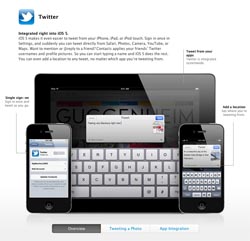Devs respond to Twitter/Apple partnership
Deep Twitter integration into iOS 5 beneficial for all, bar client devs

As revealed by Steve Jobs during Apple's WWDC keynote, iOS 5—the next version of Apple's mobile operating system, which runs on the iPhone, iPod touch and iPad—will have Twitter baked in deep. Twitter elaborated on the partnership on its blog, stating it means "you'll be able to sign in to your Twitter account once and then tweet with a single tap from Twitter-enabled apps, including Apple's apps—Camera, Photos, Safari, Contacts, YouTube, and Maps. And developers of all of your favorite apps can easily take advantage of the single sign-on capability, letting you tweet directly from their apps too."
During and after the keynote, Ryan Sarver, head of Twitter's Platform Group, was bullish on Twitter, enthusing about the partnership and also pointing at a ShareThis study, as reported on TechCrunch, that places Twitter ahead of Facebook when it comes to the average clicks per link.
Twitter versus Facebook
Mac and iOS developer Matt Gemmell considers the partnership beneficial to Twitter, since it "places an implicit endorsement of their service, and a link to download their app, right into every iOS device", although he wonders how much extra traction the service itself will get, since Twitter options are "buried within the Settings app", not prompting you to fill them in during sign-up.
Gemmell instead believes the move is more significant as a slight on Facebook, and argues that while Facebook integration could have been a bigger-ticket item from a marketing point of view, Apple may have been cautious due to Facebook's aggression regarding user data acquisition and targeting advertising. This is a viewpoint designer James Baker agrees with: "Apple and Facebook don't make sense [together], because they both want too much control over user data, one ostensibly to protect privacy, and the other… well, SkyNet."
However, Tempered Vision developer David Dixon believes the Facebook/Twitter argument is moot: "They are different services targeting very different methods of communication. Facebook profiles are by default visible to a closed network, and we already have SMS/email as a way to share between a closed network. But Twitter allows Apple to offer a consistent way to share media to an open network, rather than using a confusing array of options like Flickr and YouTube for different media types". On the negative side, Dixon is concerned with Twitter's continued profitability struggle, wondering if this raises questions about the service's longevity and stability. He adds that with Apple now so heavily invested, additional investment may happen.
Developer downturn
It's unlikely developers invested in Twitter—or at least Twitter clients—will find much to cheer about, though. "It's hard to see how a third-party developer is anything other than screwed," thinks Baker. "And Twitter has said third parties shouldn't replicate the main reading experience, which will still require a reader of choice, where 'choice' pretty much means Twitter's official client". But Gemmell at least dismisses any arguments that Twitter's latest move is hypocritical when it comes to the company's arguments regarding a consistent user experience across platforms and clients: "Twitter's position was regarding clients' presentation of tweet streams and the tweeting UI. iOS 5's Twitter integration is essentially just a single sign-on and a standard tweeting sheet—which pretty much does give a standard-enough presentation from Twitter's point of view. It's not like iOS 5's Twitter integration lets you whip up a Twitter client more easily than you could before".
Gemmell also thinks that, broadly speaking, this move will be beneficial: "Social media integration is low-hanging fruit for OS platform makers. It's usually easy to do from a technical perspective, it's popular with users, it generates buzz, and the social media platforms tend to bite your hand off if you promise to integrate with them. The only thing I'm surprised by is that it took this long before we got it."
Daily design news, reviews, how-tos and more, as picked by the editors.

The Creative Bloq team is made up of a group of art and design enthusiasts, and has changed and evolved since Creative Bloq began back in 2012. The current website team consists of eight full-time members of staff: Editor Georgia Coggan, Deputy Editor Rosie Hilder, Ecommerce Editor Beren Neale, Senior News Editor Daniel Piper, Editor, Digital Art and 3D Ian Dean, Tech Reviews Editor Erlingur Einarsson, Ecommerce Writer Beth Nicholls and Staff Writer Natalie Fear, as well as a roster of freelancers from around the world. The ImagineFX magazine team also pitch in, ensuring that content from leading digital art publication ImagineFX is represented on Creative Bloq.
